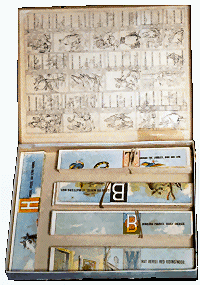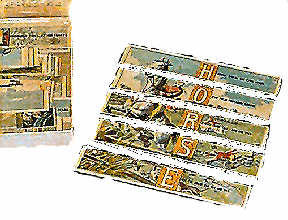
This puzzle was purchased by the Museum in 1981. There was no information available as to when the puzzle was actually manufactured and originally sold. The copyright date of 1880 is printed on the box.
On this "close-up" photograph of the boxtop, a picture of a parrot and a lion, and a jingle about the puzzle can be seen. When closed the box is 18cm long x 23cm wide x 2.25cm thick.

The lid is hinged to the bottom. Instructions are on the inner side of the lid. The box bottom contains an insert with 5 partitions for holding the pieces of the puzzle. The box partitions contain pieces for 15 different colored cardboard puzzles. Each puzzle is cut into rectangular strips 17cm long x 3.25 wide.
The number of strips in a puzzle is dependent upon the number of letters in the name of an animal. For example, a TIGER puzzle would have 5 strips, while a LION puzzle would have 4 strips. Each strip contains a part of a drawing of an animal and a drawing of part of the background of the "natural" setting in which that animal might be found. One alphabetic letter from an animal's name is on each piece. In addition, each piece includes an English language phrase about an animal with a small drawing relative to that phrase. When a puzzle is assembled correctly, each puzzle illustrates: on the left side - one animal in a setting; down the center - the animal's name spelled out in large letters; on the right side - phrases with small pictures.

While the intent of such "Educational Puzzles" is to place the puzzle pieces in a vertical alignment so that the picture is what the artist intended, it is possible to "mix and match" pieces, and create a fanciful animal. In fact, certain European sliced puzzles had been marketed with this latter intent much earlier in 19th century.
"Slicing had been used by European toy-makers, but not as a cheap alternative to dissected [jigsaw] puzzles. They used the technique for wooden Changeables. Rudolph Ackerman had published Changeable Gentleman in London in 1819 and this was followed by Changeable Ladies... Other publishers adopted the idea, slicing long, coloured aquatint landscapes, into vertical parallel strips, which could be assembled in any order." Linda Hannas, The Jigsaw Book, NY: Dial Press, 1981, p. 16.
Last update April 2, 2010